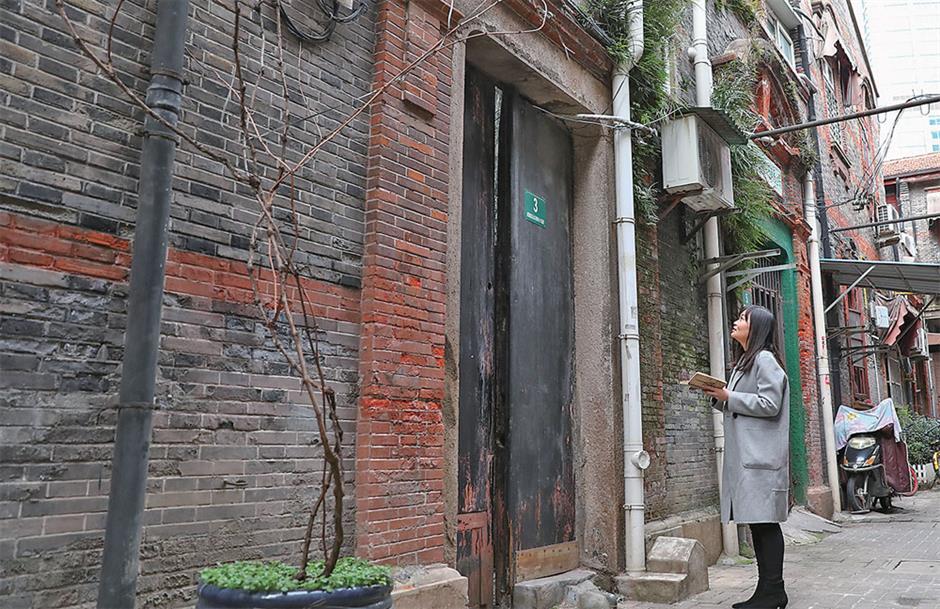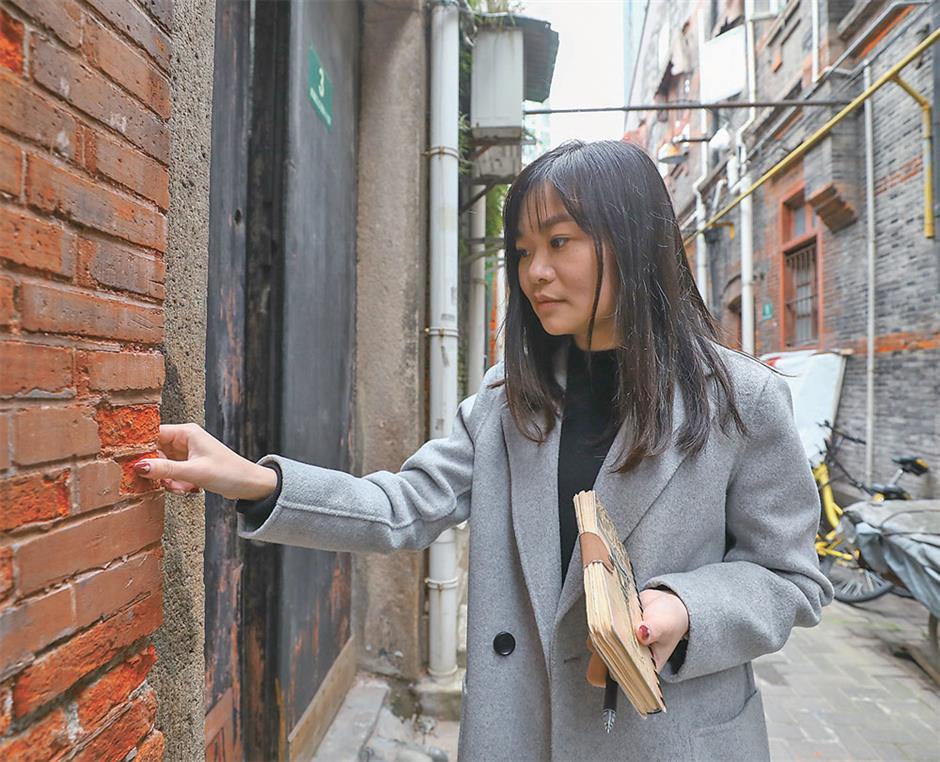
Dong Yasha takes notes of houses in Zhangyuan Garden earmarked for restoration of old buildings.
 Jiang Xiaowei / SHINE
Jiang Xiaowei / SHINEDong checks the walls in Zhangyuan Garden, a shikumen compound. She is creating “identity cards” for historical sites like Zhangyuan to store all information about the old buildings.
DONG Yasha is young but her interest is in things far beyond her age. She works in the restoration of old buildings, a profession more traditionally occupied by men.
“Buildings are alive,” she said, describing her job as “having conversations with history.”
Dong, 33, grew up in an old traditional house with her grandparents. The elegance of the old architecture permeated her soul.
In 2006, she graduated from Tongji University’s architecture school, one of the best in China. She began work with Jing’an Construction & Decoration Industrial Co, mentored by Wu Gongbao, a distinguished 40-year veteran renovator of old buildings that include the Moller Villa, the clock tower of Custom House on the Bund and the Astor House Hotel.
“I was so excited when I saw the original drawings of the clock tower of the Custom House dozens of years ago,” Dong said. “I felt like I was talking to the past.”
Restoration work is painstaking and detailed. Dong draws up restoration plans, then oversees workers who actually clean stained walls or repaint decades-old staircases.
Her mentor Wu said a competent worker doesn’t necessarily make a competent restorer. Besides skills, a restorer needs to be well educated and know English.
“Many of Shanghai’s protected buildings feature both Eastern and Western styles,” he said. “A restorer has to be able to read documents and do research.”
Dong has to climb up on rooftops and squeeze through tiny windows to check every corner of work.
“There are so many skilled craftsmen working with me,” she said. “They teach me how to apply various methods appropriate to different parts in different buildings. The job is much more than just sitting in an office, drawing up restoration plans.”
Historical documents are not always reliable.
Some years ago, Dong repaired one of Shanghai’s earliest Western villas, which featured both the styles of a Nordic log cabin and a traditional Chinese pagoda.
The villa, on Lane 9 Fenyang Road, was built 120 years ago by Robert Hart, the second inspector-general of the customs service of Qing Dynasty (1644-1911). He built the facility as a club for the foreign employees of customs.
“Drawings showed the walls were simply lined with corrugated sheet metal,” Dong said. “But we found some blank spaces beneath the walls. There should have been something there before. So we talked with elderly dwellers, who told us there used to be a filling of fish-scale tiles. We found the missing piece of the historical documents.”
In 2010, she led the restoration work on Jing’an Villa, an old residential complex.
The area was once used by the English to breed horses. In 1932, 183 Anglo-American style redbrick buildings were erected to house wealthy Westerns, entrepreneurs, celebrities and intellectuals. Later, after the prominent families moved out, the houses were partitioned into smaller flats occupied by multiple families.
“We had to restore the old neighborhood to its original environment,” Dong said. “We did a prototype first to make sure our repair methods worked.”
To restore the beautiful redbrick walls, Dong’s team used detergent to wash away stains. An added layer of paint was removed, and damaged bricks were repaired and then brushed with a protective coating.
Dong is also designing “identity cards” for registered historical sites in Zhangyuan Garden, a well-preserved shikumen compound. They will include information on the age and style of each building.
During her work, Dong meets and talks with many elderly residents.
“Many of them are well-educated and very cultivated,” she said. “They retain traces of history, like an exquisite French latch and a rare heart-shaped door handle.”
Preserving the past isn’t only about buildings. It’s also about remembering people.
“I don’t want our past to just fade away over time,” she said.
Her favorite movie is “The Legend of 1900,” which tells the story of an abandoned baby, found on an ocean liner, who grew up to be a great pianist.
“He devoted all his life chasing his dream of becoming a pianist,” Dong said, in a reflection of her job of chasing the dreams of the past.
